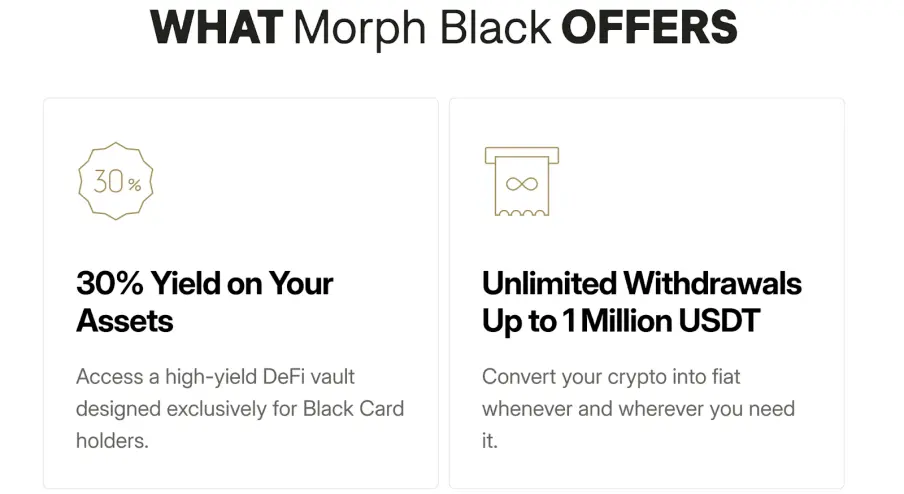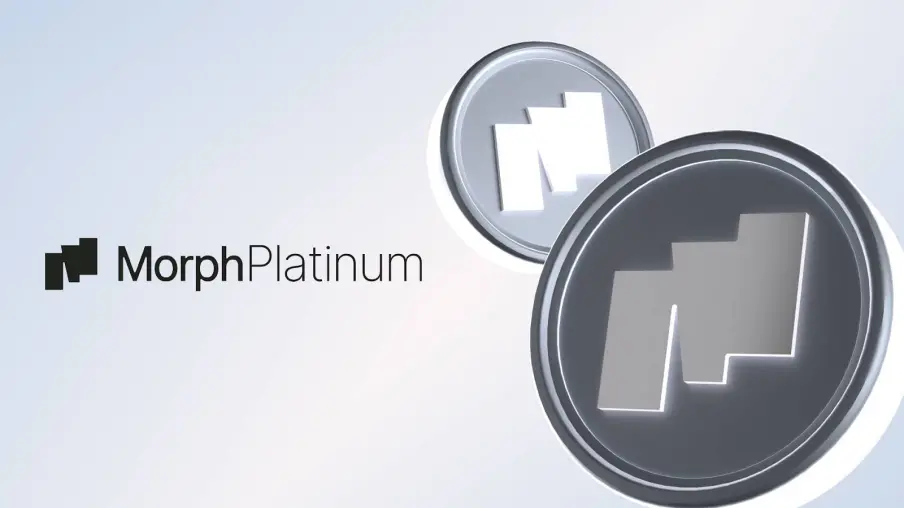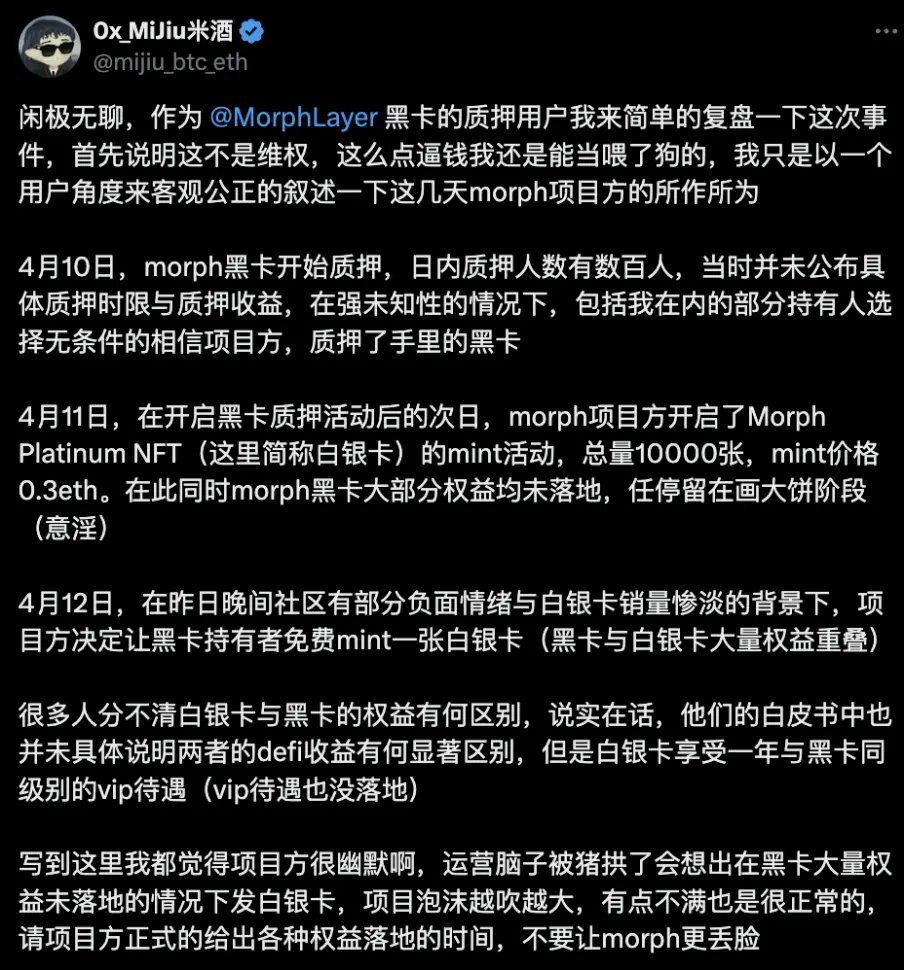Author: Patti, ChainCatcher
Editor: TB, ChainCatcher
After the release of the Platinum Soulbound NFT (Platinum Card) for the decentralized consumer-grade public chain Morph, the anticipated mint market was unexpectedly tepid.
In fact, there were many unreasonable aspects to this Platinum Card issuance:
The SBT freemint rights in the Platinum Card were airdropped for free to users who previously held Black Cards, diluting the value of the Platinum Card;
The issuance time of the Black Card and Platinum Card was too close together, and the rights were not specifically explained.
This series of actions quickly caused an uproar in the crypto community, with users beginning to question the value of the Platinum Card. Additionally, Morph's attitude and approach in handling user feedback and demands were perceived as "arrogant," which further accelerated the situation, ultimately evolving into a rights protection incident on Twitter.
Ambiguous Rights of Black Card and Platinum Card
So, what are the Black Card and Platinum Card?
As a consumer-grade infrastructure project, Morph launched the Morph Black service at the end of March this year. According to its external promotion, the Morph Black Card is a crypto card product that combines high-end rights and convenience, extending on-chain ecological application scenarios into daily life. In simple terms, users can pre-deposit funds with the issuer and then use it for daily fiat consumption like a credit card. Furthermore, Morph promised to manage the pre-deposited funds to bring users some returns.
Its core rights include exclusive DeFi high yields and high-end privileges in the real world. Morph promised that Black Card users would enjoy exclusive DeFi yield strategies, combining low-risk yield products, Morph subsidies, and ecological airdrops to provide returns far exceeding those of traditional banks and ordinary DeFi protocols.

However, reality did not match the promotion.
On April 10, the Morph Black Card began staking, with hundreds of users staking on the same day without any announcement of specific staking periods or yields, and most of the rights of the Black Card had not been realized.
Then, on April 11, the Morph project team launched the minting activity for the Morph Platinum NFT, with a total of 10,000 cards, an SBT mint price of 0.3 ETH, and a maximum of 100 SBT (equivalent to 30 ETH) that could be minted per address. Morph also promised that the Platinum Card would bring a series of high-end rights to holders, as well as the possibility of early Morph token distribution, along with rumored privileges such as "minting immediately locks in a $500 million valuation entry, and token issuance enjoys 50% liquidity," which made holders see huge potential returns and choose to "get on board."

But the fact is, the sales of the Platinum Card were dismal, with only 5% minted after the minting began. Amid such poor sales, users discovered that the project team granted Black Card holders the right to mint SBT for free, which many users considered "the biggest highlight of the Platinum Card."
Specifically, SBT represents the future early token distribution rights, which is one of the important highlights of this Platinum Card sale. Giving such an important right to Black Card holders undoubtedly diluted the significant value of this card in the eyes of Platinum Card users.
In fact, the rights related to SBT were not mentioned during the early issuance of the Black Card, and when this part of the rights was given to Black Card users after the Platinum Card was released, it seemed to users that the project team was giving away the subscription quota that could not be sold for the Platinum Card to a large number of Black Card users whose rights had not been realized, which also triggered strong opposition from users who had previously paid to mint the Platinum Card.
Additionally, attentive users noticed that the white papers for both the Platinum Card and Black Card did not clearly display specific rights, and most users could not distinguish between the Platinum Card and Black Card, while promotional materials vaguely defined their rights as "high-end rights."
Under the influence of this series of events, public sentiment began to ferment.
Official Response Sparks Community Discontent
When Morph's grand portrayal of the Platinum Card's value sharply contrasted with the dismal market sales, some users began to question the actual value of the Platinum Card, believing its promotion was overly exaggerated and lacked specific landing scenarios and practical applications. Several crypto KOLs and users voiced their concerns on social media, demanding reasonable explanations and compensation from the project team. In response, Morph quickly opened a space to appease the community.
However, this space instead became a catalyst for conflict.
During the space, users expressed their dissatisfaction and doubts about the project team. In response to the criticism, Morph emphasized that it would listen to user demands and attempted to explain the value and potential of the Platinum Card, pointing out that the cold market response was the result of multiple factors working together, rather than an issue with the product itself.
However, Morph's response attitude during the space was criticized by users. One Morph official stated that Web3 users "tend to overestimate the impact of short-term events while underestimating the value accumulated over the long term." To users, this statement implied that they were overreacting and that this minor incident would not significantly impact the entire Morph project. Such a response was perceived as overly "arrogant and indifferent" by users.
When crypto KOL Crypto Weituo called for a reassessment and adjustment of the Platinum Card's value, the Morph project team responded by stating that an additional payment of 10,000 USDT would be required for each Platinum Card to enhance the empowerment of Platinum Card users, which further fueled user anger and dissatisfaction.
Subsequently, crypto KOL Xingzhu directly requested a refund for rights protection but was cut off by the project team, making Morph the target of community criticism.
At this moment, outside the space, dissatisfaction was gradually spreading within the community. Users began to express their doubts about the value of the Platinum Card on social media and their dissatisfaction with the project team's promotional methods.
Previously, crypto blogger 0x_MiJiu called on the Morph project team to quickly provide specific explanations and timelines for the rights of both the Black Card and Platinum Card.

Crypto user Xingzhu Animaia, who participated in the Platinum Card mint, began to establish a rights protection group.

Crypto influencer Zhuque also began to criticize Morph, stating that the project team had not strengthened the corresponding rights and value after the release of the Platinum Card, but instead had repeatedly diluted its value.

Conclusion
In fact, we can see that the contradictions in this incident mainly focus on the "rights conflict" between the two cards.
As a consumer payment track, the card issuance business has always been a battleground for major consumer applications. Centralized exchanges like Binance, Coinbase, and Bitget have long joined this track, hoping to bridge the gap between crypto assets and the real economy by issuing crypto payment cards.
So, in the face of such fierce competition in the payment track, how to occupy the market high ground? The key lies in the rights attached to the payment card, which is also the problem that Morph's card issuance encountered.
Morph chose to graft physical rights similar to Web2 credit cards onto crypto payment cards to create additional selling points, but in fact, these rights are difficult to realize as a whole.
Setting aside the flashy real-world rights, the strongest highlight of crypto payment cards still lies in their fees.
Take the currently popular payment card Bybit, for example, which has transaction fees ranging from 0.9% to 3%, and new card users can enjoy a 10% cashback on their spending. Such simple and transparent rights may be the reason for the high usage rate of this type of payment card.
When the issuer solely emphasizes the future rights of crypto payment cards to seize the market, it might be better to consider from the consumer's perspective how to help users better understand the rights and realize them as soon as possible, rather than using rights as a gimmick to sell cards.
This rights protection incident is still ongoing, and the Morph project team has chosen to remain silent and has not issued any updates. Meanwhile, users who previously paid to mint the Platinum Card are still attempting to protect their rights.
Will the Morph project team further clarify the rights of the Platinum Card and Black Card in the future?
ChainCatcher will continue to monitor the progress of this event.
免责声明:本文章仅代表作者个人观点,不代表本平台的立场和观点。本文章仅供信息分享,不构成对任何人的任何投资建议。用户与作者之间的任何争议,与本平台无关。如网页中刊载的文章或图片涉及侵权,请提供相关的权利证明和身份证明发送邮件到support@aicoin.com,本平台相关工作人员将会进行核查。



